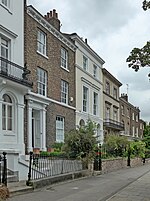York Rail Operating Centre

York Rail Operating Centre (also known as York ROC) is a Rail operating centre (ROC) located at the south western end of York railway station in York, England. The site is one of twelve that will control all signalling across the mainland of the United Kingdom. It was opened in stages from 2014 onwards, with responsibility for signalling becoming active in January 2015. The York ROC accepted the role of its predecessor, the adjacent York Integrated Electronic Control Centre (IECC), in December 2018. Of the twelve ROC signalling centres that have been built across the regions for Network Rail, York is the largest and controls the London North Eastern (LNE) region which includes the East Coast Main Line between London King's Cross and the Scottish Borders.
Excerpt from the Wikipedia article York Rail Operating Centre (License: CC BY-SA 3.0, Authors, Images).York Rail Operating Centre
Cinder Lane, York Clifton
Geographical coordinates (GPS) Address Website Nearby Places Show on map
Geographical coordinates (GPS)
| Latitude | Longitude |
|---|---|
| N 53.956111111111 ° | E -1.0971388888889 ° |
Address
York ROC and Training Centre
Cinder Lane
YO26 4AB York, Clifton
England, United Kingdom
Open on Google Maps










